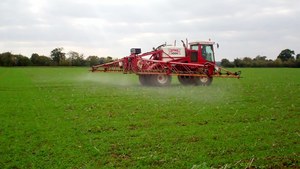On Mond ay 2nd June 1975 it snowed in Suffolk. By the end of the week the temperatures were around 250C and remained so for weeks. The subsequent dry winter meant that there was still a significant soil moisture deficit at the end of February. The following summer of 1976 was hot and dry and there was no meaningful rainfall until September. Naturally, once it started to rain it didn’t know how to stop.
ay 2nd June 1975 it snowed in Suffolk. By the end of the week the temperatures were around 250C and remained so for weeks. The subsequent dry winter meant that there was still a significant soil moisture deficit at the end of February. The following summer of 1976 was hot and dry and there was no meaningful rainfall until September. Naturally, once it started to rain it didn’t know how to stop.
This was a real problem to those with irrigated potatoes. They were worth £300/tonne (remember this was 1976) and the land was too wet for the harvesters. Luckily, that autumn/winter was also mild and so they were harvested eventually.
The biggest problem then was the potential tax bill. In my opinion, much money was wasted on unnecessary expenditure in an effort to reduce it. Perhaps today more sophisticated ways of avoiding taxes would be adopted. But, I’m not going there!
So farming in extreme weather conditions is not new. However, we seem to have recently been experiencing more prolonged periods of rain…or drought…or high or low temperatures. Until it happened this year, who would’ve thought that there could be active brown rust in wheat around Newcastle in March?
How do we manage crops in such variable weather conditions?
With fixed costs, it’s important that such variation is borne in mind, and minimising labour and machinery for the fabled ‘average’ season will obviously not be the best strategy.
With our input management there are many issues to discuss on the requirement, timing and amount of individual inputs in addition to the overall strategy. For instance, seed rates can influence moisture loss from the crop, particularly if there is a dry winter. This may be critical if there is a dry ripening period. I remember seeing a winter wheat seed rate trial in New Zealand where the higher seed rate plots had ‘hayed off’ because of associated higher moisture losses at earlier stages of growth. On the other hand, reasonable seed rates are required to compete with herbicide resistant black-grass and to minimise the impact of tiller loss during a dry spring.
Last year we got yield responses to chlormequat use in winter wheat. This was because chlormequat increased the number of potential grain sites by reducing the loss of grain sites in the very dry spring. The increased yields came from the great grain fill conditions experienced in June and July which enabled these additional grain sites to be filled.
But it could have gone the other way. More grain sites than considered wise by the untreated crop at, and shortly after, the time of the application of chlormequat would have resulted in more ‘tail corn’ and lower harvested yields should the dry conditions have continued into June and July.
Perhaps my most sobering experience of the impact of drought on crop inputs was in 1976. Over the previous winter I, as a lowly ADAS district adviser, had had heated discussions with soil scientists on the optimum dose of applied N for wheat.
This was the time when yields were beginning to rise rapidly and I was convinced that the then recommendation of 125 kg N/ha was too low. However, I didn’t win the argument and recommendations for 1976 stayed the same. I had to be content with the knowledge that there were plenty of N trials in the ground and they would prove me right!
However, it was so dry that the optima in nearly all these trials were zero applied N. Presumably, the additional moisture loss from the extra green area created by applied nitrogen negated the value of its ability to trap more solar radiation. You must remember that we were then talking of yields of 4-5 t/ha.
One unexpected result from last year was that urea and ammonium nitrate applied during the extremely dry spring produced the same wheat yields. It seems that significant ammonia losses from urea will not occur until moisture starts to affect the integrity of the applied material. So losses can be minimal when applied in extremely dry conditions provided that there is sufficient rain when the drought breaks to quickly ‘wash’ the urea into the soil.
Conclusion: adjusting inputs to take into account more variable weather conditions is fraught with difficulty. It comes down to risk management based on experience, good information sources and sound science.
By the way, the reason why I remember the snow in June 1975? I was playing in a golf tournament at the time. For the less informed, you play golf with a white ball.
